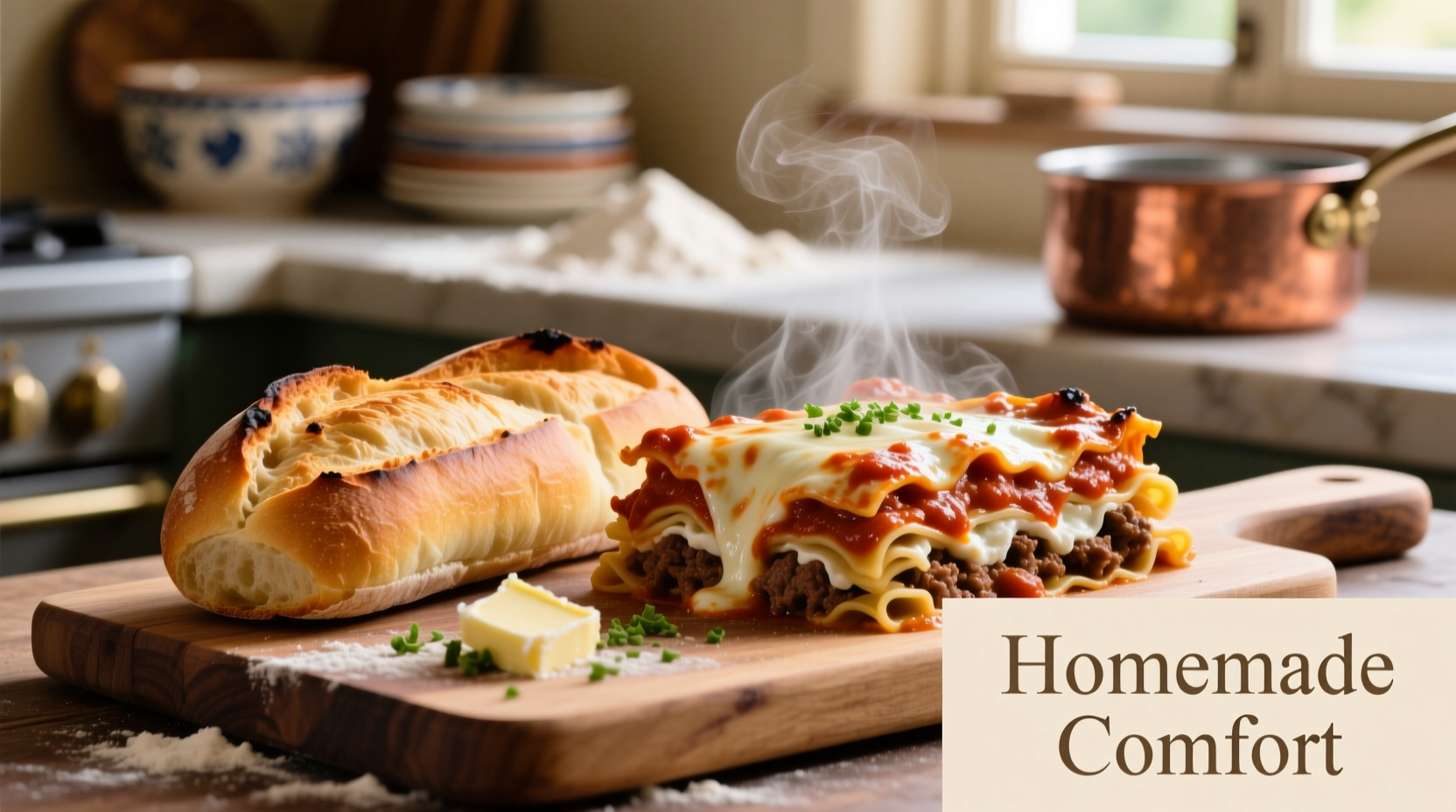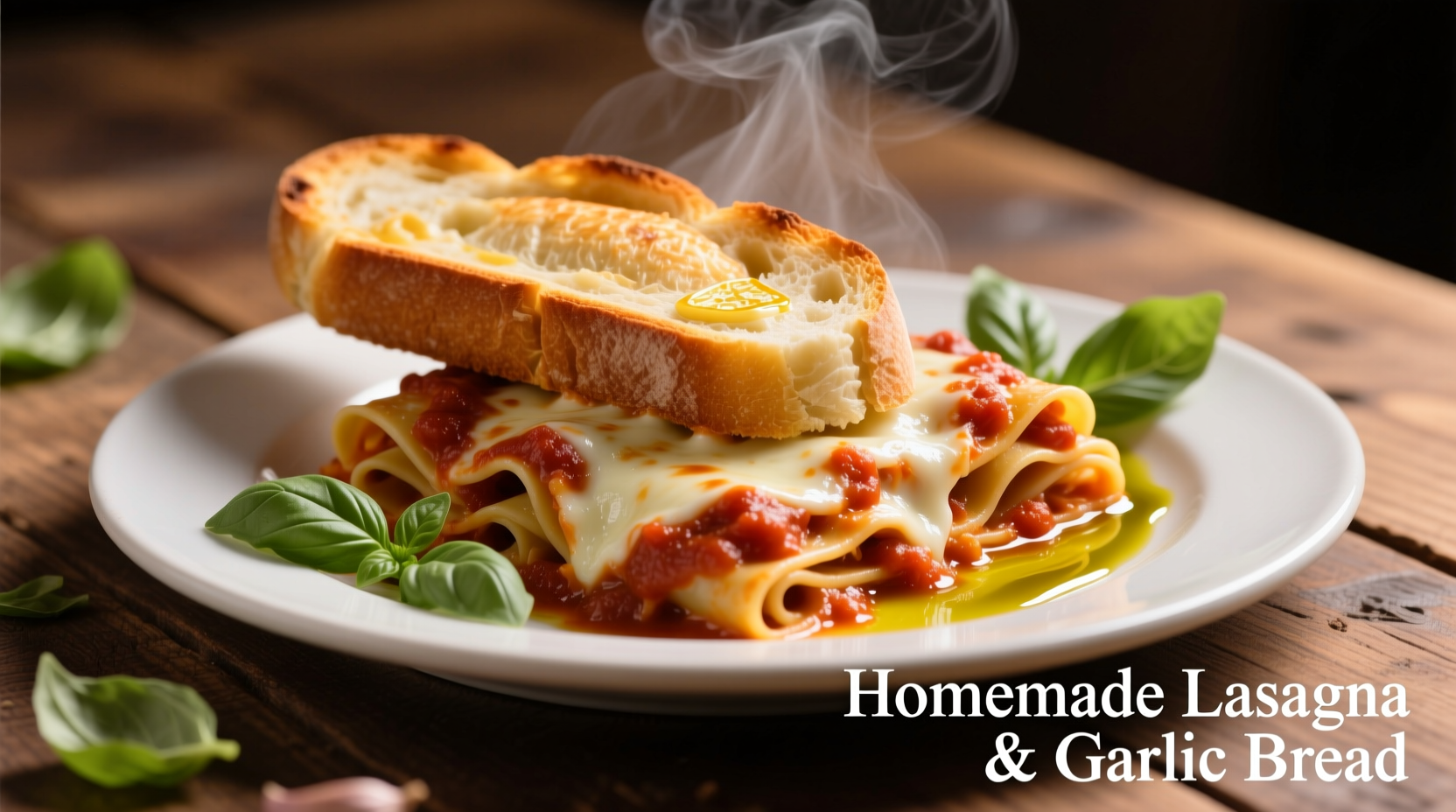There's a reason this pairing has endured for decades across dining tables worldwide. When crafted properly, garlic bread doesn't just accompany lasagna—it elevates the entire meal through thoughtful flavor layering and textural contrast.
The Science Behind the Perfect Pairing
Understanding why garlic bread works so well with lasagna requires examining both culinary chemistry and sensory experience. The volatile compounds in fresh garlic—particularly allicin—interact with the umami-rich tomato sauce and creamy cheese layers in lasagna, creating a harmonious flavor profile that satisfies multiple taste receptors simultaneously.
| Flavor Component | Lasagna Contribution | Garlic Bread Enhancement |
|---|---|---|
| Umami | Tomato sauce, aged cheeses | Garlic compounds intensify umami perception |
| Fat | Cheese, meat layers | Bread's crisp texture cuts through richness |
| Acidity | Tomato sauce | Garlic's sharpness balances acidity |
| Texture | Soft, layered pasta | Crisp exterior provides contrast |
When to Serve Garlic Bread with Your Lasagna
Timing matters as much as the recipe itself. Professional chefs recommend serving garlic bread at two strategic points during your lasagna meal:
Pre-Meal Presentation (5-7 minutes before serving)
Present warm garlic bread alongside a small dish of high-quality olive oil for dipping. This accomplishes three things:
- Prepares the palate with aromatic compounds that enhance subsequent flavors
- Provides a textural contrast to the upcoming soft lasagna layers
- Creates an immediate sensory experience that builds anticipation
During the Meal (With the first lasagna portion)
For optimal enjoyment, serve additional garlic bread alongside the first portion of lasagna. The bread's crisp texture helps cut through the richness of the cheese and meat layers, preventing palate fatigue as you continue eating.

Authentic Recipe Variations Worth Trying
While traditional garlic bread uses French or Italian bread, butter, garlic, and parsley, authentic Italian-American variations offer distinct advantages when pairing with lasagna:
Classic Italian-American Garlic Bread
This version balances richness without overwhelming your lasagna:
- Use day-old ciabatta for superior texture retention
- Rub bread with cut garlic cloves rather than mixing minced garlic into butter
- Add a pinch of red pepper flakes to complement tomato-based lasagna sauces
- Finish with fresh parsley after baking to preserve vibrant flavor
Garlic Herb Focaccia Alternative
For a more substantial pairing that stands up to meat-heavy lasagnas:
- Use pre-baked focaccia as your base
- Infuse olive oil with rosemary and thyme before adding garlic
- Sprinkle with Parmesan during the last two minutes of baking
- Serve cut into small squares for easier sharing
Historical Context: How This Pairing Became Standard
The marriage of garlic bread and lasagna isn't ancient Italian tradition but rather an evolution of Italian-American culinary innovation:
| Time Period | Development | Impact on Lasagna Pairing |
|---|---|---|
| 1920s-1940s | Italian immigrants adapt recipes using available American ingredients | Garlic bread emerges as affordable alternative to traditional Italian bread service |
| 1950s | Rise of Italian-American restaurants in major US cities | Restaurants begin pairing garlic bread with pasta dishes as standard offering |
| 1960s-1970s | Convenience foods become popular | Pre-made garlic bread products reinforce the pairing in home cooking |
| 1980s-Present | Food media explosion | Cooking shows and magazines cement garlic bread as essential lasagna accompaniment |
Common Mistakes That Ruin the Pairing
Even experienced home cooks make these critical errors when serving garlic bread with lasagna:
Overpowering Garlic Flavor
Using too much raw garlic creates an overwhelming sharpness that clashes with lasagna's complex flavors. Instead, roast whole garlic cloves and mash them into your butter for a sweeter, more nuanced garlic flavor that complements rather than competes.
Serving at the Wrong Temperature
Garlic bread served too hot masks subtle flavor notes, while cold bread lacks aromatic appeal. The ideal serving temperature is 140-150°F (60-65°C)—warm enough to release aromatic compounds but cool enough to appreciate layered flavors.
Neglecting Texture Balance
When both dishes are too soft (soggy bread with soft lasagna), the meal becomes texturally monotonous. Ensure your garlic bread has a crisp exterior with a slightly chewy interior to provide necessary contrast to lasagna's layered softness.
When NOT to Serve Garlic Bread with Lasagna
While generally complementary, certain lasagna preparations warrant alternative sides:
- Cheese-heavy vegetarian lasagnas—the additional richness can overwhelm the palate; try a simple arugula salad instead
- Seafood lasagnas—garlic bread's strong flavors compete with delicate seafood; opt for a light lemon-herb bread
- White sauce (béchamel) based lasagnas—consider a rosemary focaccia that complements rather than competes
Storage and Reheating for Leftovers
Proper storage maintains the delicate balance between these dishes:
- Store garlic bread separately from lasagna to prevent moisture transfer
- Reheat garlic bread in a 350°F (175°C) oven for 3-5 minutes—never microwave
- Serve reheated garlic bread alongside room-temperature lasagna portions for optimal flavor release
- Refresh garlic bread with a light mist of olive oil before reheating if needed











 浙公网安备
33010002000092号
浙公网安备
33010002000092号 浙B2-20120091-4
浙B2-20120091-4